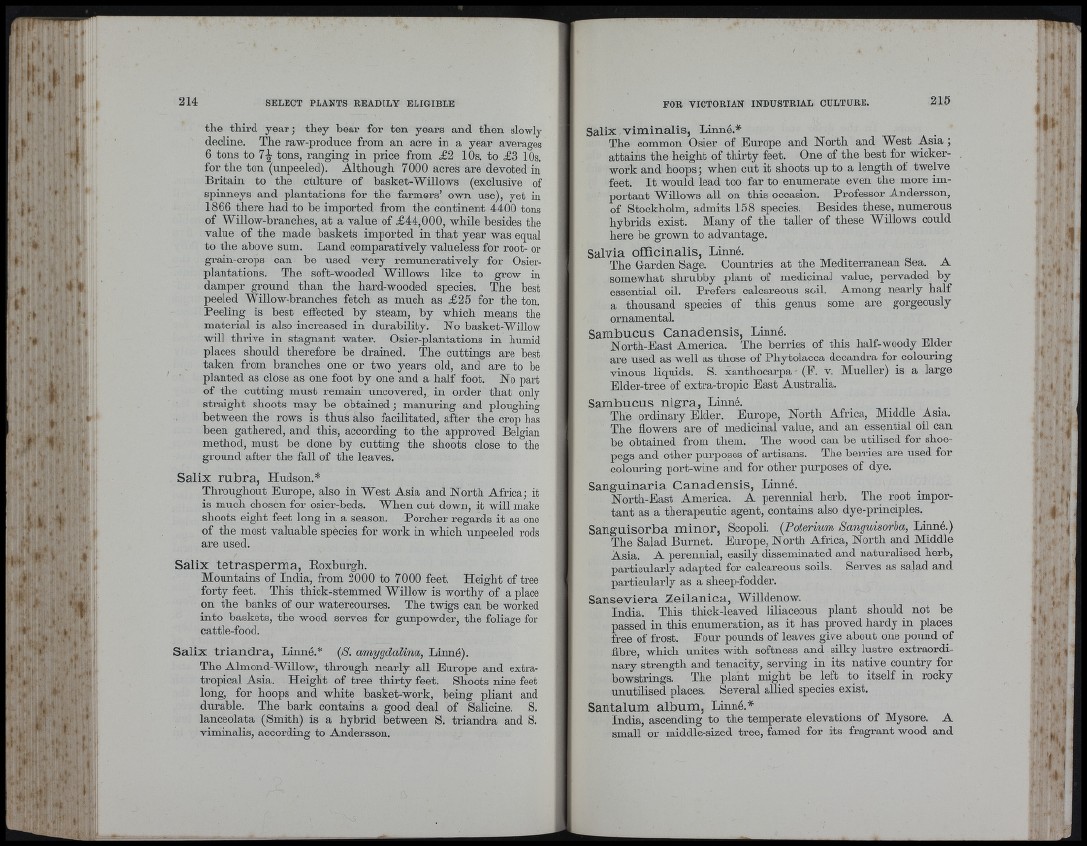
Î. «
the third year; they bear for ten years and then slowly
decline. The raw-produce from an acre in a year averages
6 tons to 7^ tons, ranging in price from £2 10s. to £3 10s.
for the ton (unpeeled). Although 7000 acres are devoted in
Britain to the culture of basket-Willows (exclusive of
spinneys and plantations for the farmers’ own use), yet in
1866 there had to be imported from tbe continent 4400 tons
of Willow-branches, at a value of £44,000, while besides the
value of the made baskets imported in that year was equal
to tbe above sum. Land comparatively valueless for root- or
grain-crops can be used very remuneratively for Osier-
plantations. Tbe soft-wooded Willows like to grow in
damper ground than tbe liard-wooded species. The best
peeled Willow-branches fetch as much as £25 for the ton.
Peeling is best effected by steam, by which means the
material is also increased in durability. No basket-Willow
will thrive in stagnant water. Osier-plantations in humid
places should therefore be drained. The cuttings are best
taken from branches one or two years old, and are to he
planted as close as one foot by one and a half foot. No part
of the cutting must remain uncovered, in order that only
straight shoots may be obtained ; manuring and ploughing
between tbe rows is thus also facilitated, after tbe crop has
been gathered, and tbis, according to tbe approved Belgian
method, must be done by cutting the shoots close to the
gi'ound after the fall of the leaves.
Salix rubra, Hudson.*
Tbronghout Europe, also in West Asia and North Africa; it
is much chosen for osier-beds. When cut down, it will make
shoots eight feet long in a season. Porcher regards it as one
of the most valuable species for work in wbicb nnpeeled rods
are used.
Salix tetrasperma, Roxburgh.
Mountains of India, from 2000 to 7000 feet. Height of tree
forty feet. This thick-stemmed Willow is worthy of a place
on tbe banks of our watercourses. Tbe twigs can be worked
into baskets, the wood serves for gunpowder, the foliage for
cattle-food.
Salix triandra, Linné.* (S. amygdalina, Linné).
The Almond-Willow, through nearly all Europe and extra-
tropical Asia. Height of tree thirty feet. Shoots nine feet
long, for hoops and white basket-work, being pliant and
durable. Tbe bark contains a good deal of Salicine. S.
lanceolata (Smith) is a hybrid between S. triandra and S.
viminalis, according to Andersson.
Salix viminalis, Linné.*
The common Osier of Europe and North and West Asia ;
attains the height of thirty feet. One of the best for wickerwork
and hoops; when cut it shoots up to a length of twelve
feet. I t would lead too far to enumerate even the more important
Willows all on this occasion. Professor Andersson,
of Stockholm, admits 158 species. Besides these, numerous
hybrids exist. Many of the taller of these Willows could
here be grown to advantage.
Salvia officinalis, Linné.
The G-arden Sage. Countries at the Mediterranean Sea. A
somewhat shrubby plant of medicinal value, pervaded by
essential oil. Prefers calcareous soil. Among nearly half
a thousand species of tbis genus some are gorgeously
ornamental.
Sambucus Canadensis, Linné.
North-East America. The berries of this half-woody Elder
are used as well as those of Phytolacca decandra for colouring
vinous liquids. S. xanthocarpa (F. v. Mueller) is a large
Elder-tree of extra-tropic East Australia.
Sambucus nigra, Linné.
The ordinary Eider. Europe, North Africa, Middle Asia.
The flowers are of medicinal value, and an essential oil can
be obtained from them. The wood can be utilised for sboe-
pegs and other purposes of artisans. Tbe berries are used for
colouring port-wine and for otber purposes of dye.
Sanguinaria Canadensis, Linné.
North-East America. A perennial herb. The root important
as a therapeutic agent, contains also dye-principles.
Sanguisorba minor, Scopoli. {Poterium Sanguisorha, Linné.)
The Salad Burnet. Europe, North Africa, North and Middle
Asia. A perennial, easily disseminated and naturalised herb,
particularly adapted for calcareous soils. Serves as salad and
particularly as a sbeep-fodder.
Sanseviera Zeilanica, Willdenow.
India. Tbis thick-leaved liliaceous plant should not be
passed in this enumeration, as it has proved hardy in places
free of frost. Four pounds of leaves give about one poimd of
fibre, wbicb unites with softness and silky lustre extraordinary
strength and tenacity, serving in its native country for
bowstrings. Tbe plant might be left to itself in rocky
unutilised places. Several allied species exist.
Santalum album, Linné.*
India, ascending to the temperate elevations of Mysore. A
H-mall or middle-sized tree, famed for its fragrant wood and
I i
Mi
I